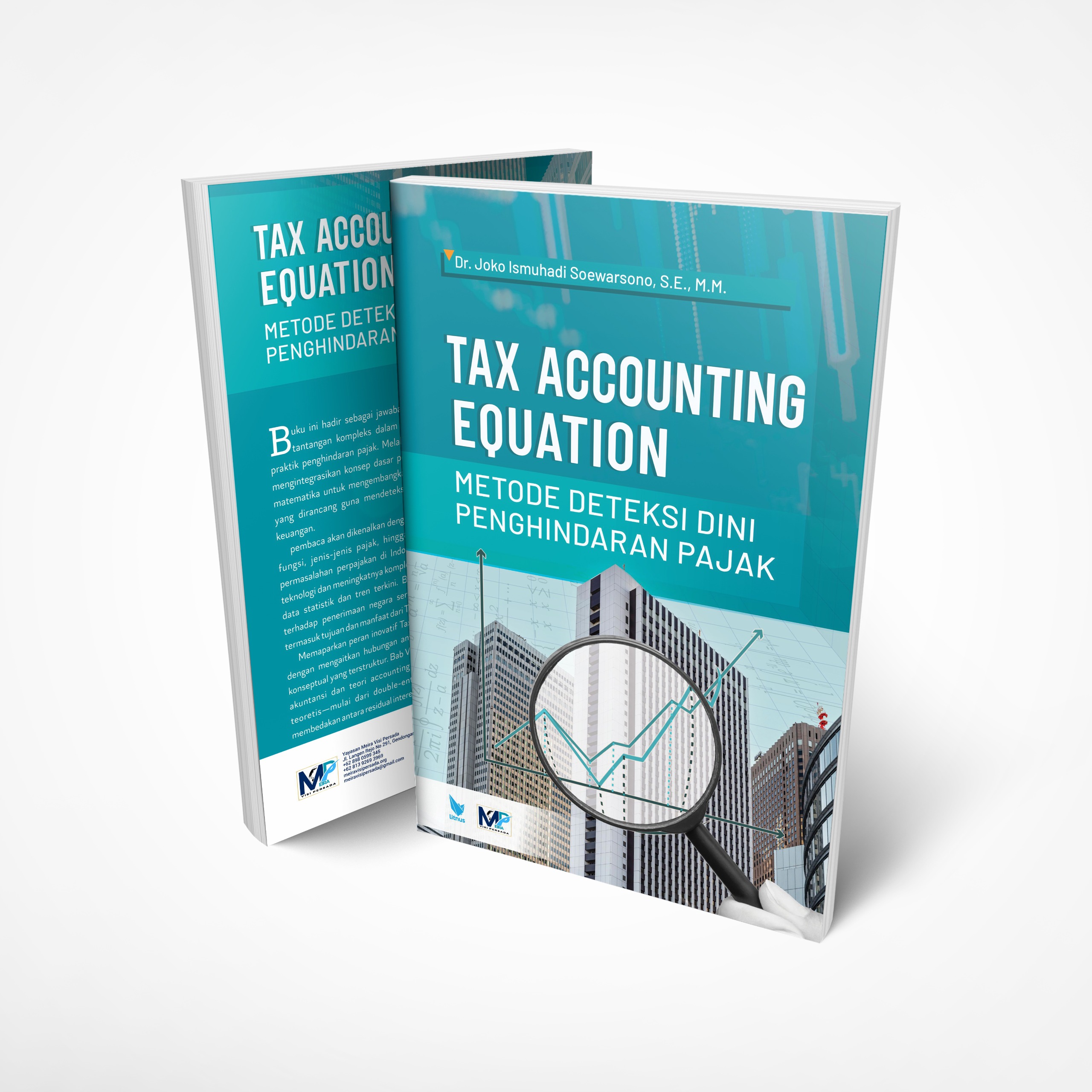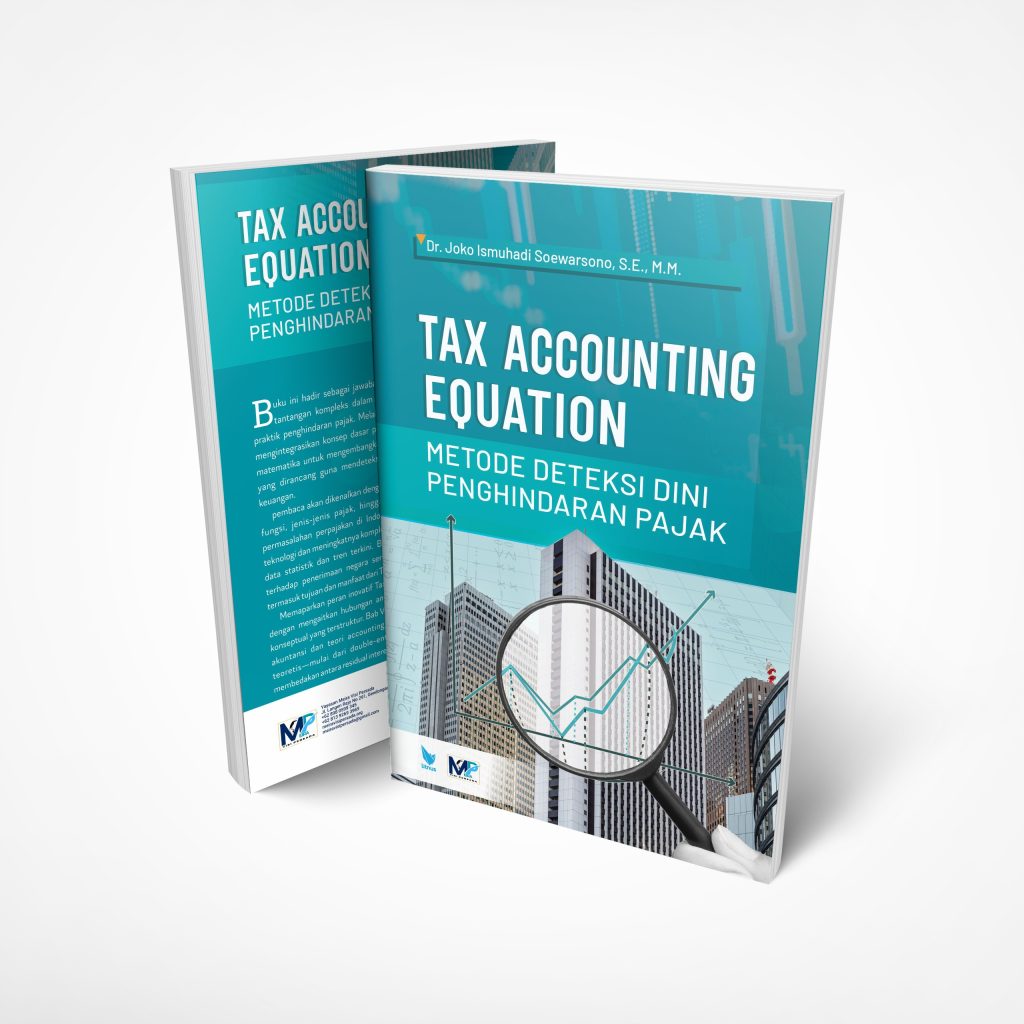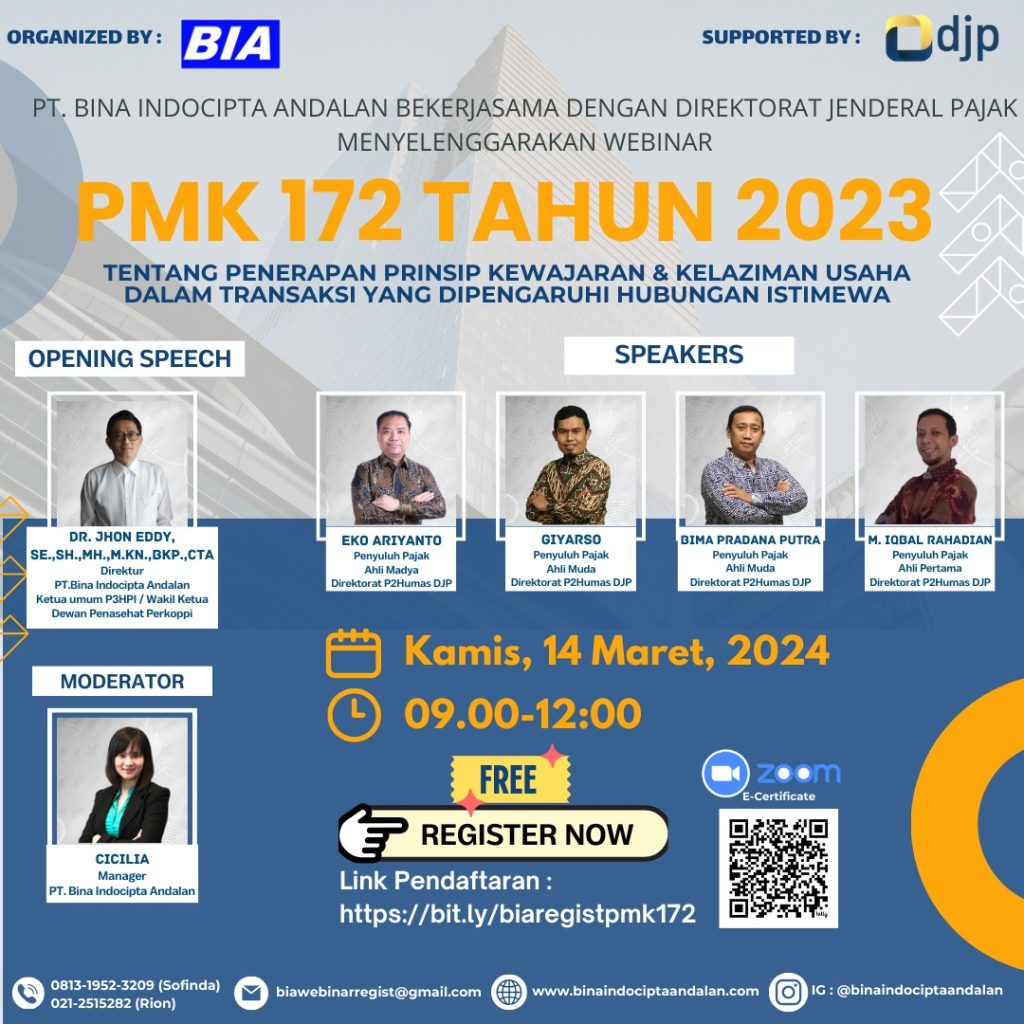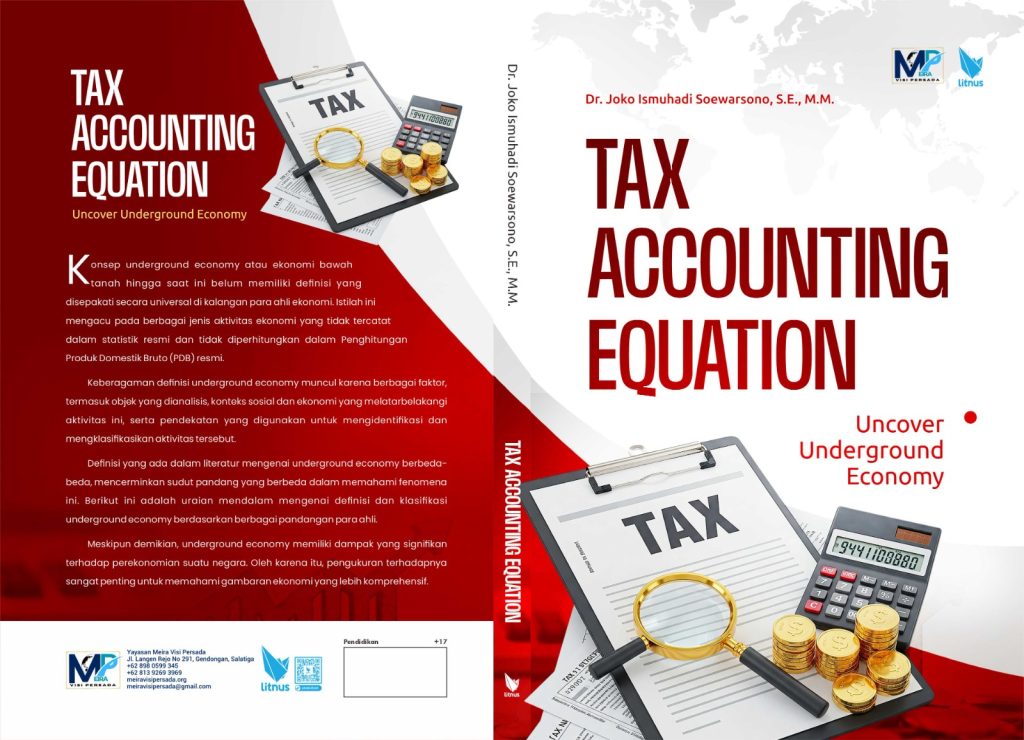
Integrating Dr. Joko Ismuhadi’s Tax Accounting Equation into a Self-Assessment Monitoring System for Enhanced Tax Compliance
- Ekonomi
Sunday, 18 May 2025 00:52 WIB

Jakarta, fiskusnews.com:
1. Executive Summary: Enhancing Tax Compliance through Integrated Systems
This report examines the integration of Dr. Joko Ismuhadi’s Tax Accounting Equation (TAE) into a self-assessment monitoring system (SAMS) as a means to enhance tax compliance for businesses and organizations. The analysis indicates that this integration offers a powerful, proactive approach to managing tax obligations and mitigating risks, particularly within the Indonesian context where TAE was developed. By leveraging the forensic accounting capabilities of TAE within the structured framework of a SAMS, organizations can establish a data-driven internal mechanism for identifying potential tax irregularities, ensuring the accuracy of financial data, and fostering a stronger culture of compliance. This report details the principles of TAE and SAMS, explores the practicalities and benefits of their integration, considers the specific context of Indonesia, discusses the role of internal control frameworks and tax risk management, and offers recommendations for successful implementation.
2. Introduction: The Evolving Landscape of Tax Compliance and the Role of Proactive Monitoring
The realm of tax compliance is increasingly characterized by intricate regulations and a global movement towards self-assessment systems. This shift places a significant onus on taxpayers to accurately calculate, report, and remit their tax liabilities. Indonesia, having adopted the self-assessment system in 1984, exemplifies this trend. This reliance on taxpayers necessitates the implementation of robust internal monitoring mechanisms within organizations to safeguard against errors and intentional misstatements, thereby ensuring the integrity of the self-assessment process.
In response to the complexities of tax compliance and the need for advanced detection of financial irregularities, Dr. Joko Ismuhadi, an Indonesian tax specialist, introduced the Tax Accounting Equation (TAE). This innovative tool adapts fundamental accounting principles to the specific context of Indonesian tax analysis, aiming to provide a more targeted approach to identifying potential tax evasion. The development of TAE within Indonesia suggests its design considers the unique challenges and characteristics of the nation’s financial and regulatory environment.
Complementing the analytical power of TAE is the concept of Self-Assessment Monitoring Systems (SAMS). While initially applied to domains like IT and cybersecurity, the core principles of a SAMS – self-evaluation, proactive risk identification, and continuous improvement – hold significant value for modern tax management. A System Monitoring Self Assessment (SMSA) program, for instance, enhances IT and cybersecurity practices through the self-evaluation of monitoring capabilities to pinpoint areas for improvement and potential risks. Extending these principles to tax compliance can empower organizations to enhance self-awareness regarding their tax obligations, promote accountability across finance and accounting teams, and proactively detect potential issues before they escalate.
The integration of Dr. Ismuhadi’s Tax Accounting Equation into a Self-Assessment Monitoring System presents a promising synergy for bolstering tax compliance. By embedding a forensic accounting tool like TAE within a proactive monitoring framework, organizations can establish a data-driven internal mechanism for identifying potential tax risks and ensuring the accuracy of their financial data. This integrated approach has the potential to significantly improve how businesses and organizations in Indonesia and potentially beyond manage their tax obligations in an increasingly complex regulatory landscape.
3. Deconstructing Dr. Joko Ismuhadi’s Tax Accounting Equation (TAE): A Forensic Accounting Tool
The foundation of financial accounting rests upon the basic accounting equation: Assets = Liabilities + Equity. This equation represents the equilibrium between a company’s resources (assets) and the sources of its financing, whether through borrowing (liabilities) or owner investments (equity). While fundamental for understanding a company’s financial position, this equation’s general nature may not be sufficiently discerning to uncover the often concealed and intricate methods employed in sophisticated tax evasion. Tax evasion frequently involves the misclassification or concealment of economic activities, which might not create a significant imbalance in the basic accounting equation, thus limiting its effectiveness as a forensic tool in tax analysis.
In response to these limitations, Dr. Ismuhadi formulated the Tax Accounting Equation (TAE) in two interrelated forms:
- Revenue – Expenses = Assets – Liabilities
- Revenue = Expenses + Assets – Liabilities
These formulations represent a strategic rearrangement of the basic accounting equation, with a deliberate emphasis on revenue as a critical indicator of a company’s economic activity and its consequent tax obligations. By focusing on the relationship between a company’s profitability, as reflected in the income statement (Revenue – Expenses), and its net worth, as shown on the balance sheet (Assets – Liabilities), TAE aims to provide a more targeted lens for identifying potential tax irregularities. This focus on revenue is particularly significant as underreporting income is a common tactic in tax evasion.
The underlying mathematical principle of TAE is to establish an expected equilibrium between key financial reporting components and a company’s tax obligations. By mathematically linking revenue, expenses, assets, and liabilities, TAE provides a framework for tax authorities and organizations to quantitatively assess financial statements. Significant deviations from these anticipated relationships can then serve as indicators of potential tax avoidance or even fraudulent activities. For instance, an unusually high level of liabilities relative to reported revenue growth could suggest intentional misclassification of income as debt to reduce tax burden.
Furthermore, for specific scenarios where taxable income might be intentionally reported as zero or negative to minimize tax liabilities, Dr. Ismuhadi also formulated the Mathematical Accounting Equation (MAE) as: Assets + Dividen + Beban = Kewajiban + Ekuitas + Pendapatan. This equation further refines the analytical approach to address situations where income statement manipulation might not be the primary method of tax avoidance.
The Tax Accounting Equation is particularly relevant and designed for the Indonesian financial and regulatory landscape. Developed by an Indonesian tax expert, TAE takes into account the specific challenges and characteristics of the Indonesian economy, including the prevalence of the underground economy and various tax evasion tactics. Dr. Ismuhadi’s deep understanding of the Indonesian tax system, likely informed by his experience within the tax authority , has been instrumental in developing an equation that targets specific financial reporting patterns and manipulations commonly observed in Indonesia. For example, inconsistencies between a company’s reported profitability and its net worth, as highlighted by TAE, can signal potential manipulation of financial statements to evade taxes. The use of clearing accounts to temporarily misrecord revenues as liabilities or expenses as assets is another deceptive practice that TAE is designed to detect.
To further illustrate the distinction, the following table compares the basic accounting equation with Dr. Ismuhadi’s Tax Accounting Equation:
Table 1: Comparison of Basic Accounting Equation and Tax Accounting Equation
| Feature | Basic Accounting Equation | Tax Accounting Equation (TAE) |
| Formula | Assets = Liabilities + Equity | Revenue – Expenses = Assets – Liabilities; Revenue = Expenses + Assets – Liabilities |
| Emphasis/Focus | Financial Position | Profitability and its relation to Net Worth, Revenue as key indicator |
| Primary Use | General Financial Reporting | Forensic Tax Analysis, Early Detection of Tax Irregularities |
Ekspor ke Spreadsheet
This comparison underscores how TAE builds upon the fundamental accounting equation to provide a more focused and potentially effective tool for identifying tax-related discrepancies, particularly within the Indonesian context.
4. Understanding Self-Assessment Monitoring Systems (SAMS): Principles and Best Practices
A Self-Assessment Monitoring System (SAMS) encompasses a structured approach for organizations to evaluate their own processes and controls to identify areas for improvement and potential risks. In the context of tax compliance, a SAMS serves as a proactive mechanism to enhance self-awareness regarding tax obligations, promote accountability within relevant teams, and facilitate the early detection of potential tax-related issues. The ultimate goal is to improve operational excellence in tax management and strengthen the organization’s tax compliance posture, thereby reducing the risk of penalties and ensuring adherence to regulatory requirements.
An effective SAMS framework for tax compliance should incorporate several key elements. Firstly, it requires clearly defined objectives and scope, specifying the particular tax processes or areas that will be subject to self-assessment. Secondly, it needs well-established assessment criteria and metrics to provide a basis for evaluating compliance and identifying deviations. Active involvement of relevant stakeholders from finance, accounting, and potentially legal departments is crucial to ensure a comprehensive and accurate assessment. A structured assessment process, outlining the steps and procedures for conducting the self-assessment, is also essential. Finally, robust reporting and follow-up mechanisms must be in place to communicate the findings, track any identified issues, and ensure that corrective actions are taken.
Leveraging monitoring maturity models can significantly enhance the SAMS process for tax compliance. These models provide benchmarks for assessing the organization’s current tax compliance monitoring capabilities and offer a roadmap for future improvement. By understanding their current maturity level, organizations can identify specific areas where they need to enhance their processes and controls to achieve a higher level of tax compliance and risk management.
While there isn’t a specific off-the-shelf “Tax Accounting Equation integrated self-assessment monitoring system” software package widely available under that exact name, organizations can draw inspiration from existing tools, checklists, and frameworks used in other domains, such as IT governance. Frameworks like COBIT, for instance, provide guidance on IT governance and management, and their principles related to risk management and control can be adapted to a tax compliance context. Similarly, checklists and self-assessment tools used for standards like PCI DSS or CIS Controls, while focused on security, offer methodologies for self-evaluation that can be tailored for tax compliance assessments. Organizations can also customize their internal systems or use spreadsheet-based analyses to leverage the power of Dr. Ismuhadi’s equation for their own monitoring purposes.
To ensure the successful implementation and sustainability of a tax compliance SAMS, organizations should adhere to several best practices. It is advisable to start with a focused scope, targeting specific tax processes or areas that pose the highest risk or are of greatest concern. Utilizing simple and accessible tools for self-assessment can encourage broader participation and ease of use. Consistency is key, and organizations should strive to integrate self-assessment activities into their regular operational routines to ensure continuous monitoring. Providing regular feedback and reinforcement by sharing the results of the self-assessments and acknowledging improvements can help foster a positive and proactive compliance culture. Actively involving and engaging stakeholders from different departments allows for a more comprehensive understanding of tax compliance risks and challenges. Emphasizing positive framing and improvement by presenting self-assessment as an opportunity for reflection and identifying areas for enhancement, rather than solely focusing on deficiencies, can encourage a more constructive mindset. Finally, it is crucial to continuously review and update the assessment framework, criteria, and tools based on feedback and evolving tax regulations and organizational needs.
The following table adapts best practices for implementing a System Monitoring Self Assessment (SMSA) for IT and cybersecurity to the context of tax compliance:
Table 3: Best Practices for Implementing a Tax Compliance SAMS (Adapted from IT SMSA)
| Best Practice | Description | Relevance to Tax Compliance | |
| Start with a focused scope | Begin by focusing on a limited number of critical tax processes or high-risk areas. | Allows for a more detailed and thorough initial assessment, increasing the likelihood of achieving meaningful results early on in tax compliance. | |
| Utilize user-friendly tools | Employ simple and accessible tools for self-assessment, such as spreadsheets or customized templates. | Encourages broader participation from finance and accounting teams, reducing the learning curve and making the process more efficient for tax compliance. | |
| Ensure consistent tracking | Integrate self-assessment activities into regular operational routines to provide a continuous feedback loop. | Enables ongoing monitoring of tax compliance, allowing for the timely detection of emerging risks and supporting continuous improvement in tax management practices. | |
| Provide regular feedback | Share the results of self-assessments and acknowledge improvements to reinforce positive behaviors and encourage ongoing participation. | Motivates finance and accounting teams to actively engage in the self-assessment process for tax compliance and fosters a culture of continuous improvement in tax-related activities. | |
| Actively involve stakeholders | Engage relevant personnel from finance, accounting, and potentially legal departments in defining assessment criteria and selecting target areas. | Ensures a comprehensive understanding of tax compliance risks and challenges from different perspectives within the organization, leading to more effective self-assessment outcomes. | |
| Emphasize positive framing | Present self-assessment as a valuable opportunity to objectively reflect on tax-related work and identify potential avenues for improvement, rather than solely focusing on pinpointing deficiencies. | Fosters a more positive and growth-oriented mindset among finance and accounting teams towards tax compliance, encouraging proactive identification and resolution of potential issues. | |
| Continuously review and update | Regularly review and update the assessment framework, criteria, and tools based on feedback and evolving tax regulations and organizational requirements. | Ensures that the tax compliance SAMS remains relevant and effective over time, adapting to changes in the tax environment and shifting organizational needs related to financial reporting and regulatory adherence. |
By adhering to these principles and best practices, organizations can establish a robust and effective Self-Assessment Monitoring System for tax compliance, laying the groundwork for the successful integration of Dr. Ismuhadi’s Tax Accounting Equation.
5. Integrating the Tax Accounting Equation (TAE) into a Self-Assessment Monitoring System: A Practical Approach
The Tax Accounting Equation (TAE) can be seamlessly integrated into a self-assessment monitoring system to provide a powerful layer of analysis for enhancing tax compliance. This integration allows organizations to leverage the forensic capabilities of TAE within a structured and proactive monitoring framework.
Internal Compliance Checks: Organizations can utilize TAE as a routine internal check on their financial data. By regularly calculating and monitoring the relationships outlined in the equation (Revenue – Expenses = Assets – Liabilities or Revenue = Expenses + Assets – Liabilities), companies can identify any unusual fluctuations or discrepancies in their financial records. For instance, a sudden increase in assets without a corresponding increase in revenue or decrease in liabilities might indicate potential underreporting of income or misclassification of transactions. These checks can be performed on a periodic basis, such as monthly or quarterly, to ensure ongoing monitoring of financial data integrity from a tax perspective.
Risk Assessment: Deviations from the expected balances in TAE can serve as early warning indicators of potential tax risks. By establishing acceptable ranges for the TAE relationship, any significant variance can trigger an alert, prompting further investigation into the underlying financial data and accounting practices. This proactive risk assessment allows organizations to address potential tax issues internally before they escalate or are flagged by external auditors or tax authorities. For example, a consistent negative deviation in the equation could suggest aggressive expense reporting or potential revenue leakage, warranting a focused review of these areas.
Data Quality Assurance: Implementing TAE as a self-assessment tool can significantly contribute to improving the accuracy and consistency of financial data entry and reporting processes. Significant imbalances in the TAE calculation might point to errors in the recording of revenue, expenses, assets, or liabilities. For instance, if the equation does not balance, it could indicate a data entry error, a misclassification of an account, or an inconsistency in the application of accounting principles. By using TAE as a validation check, organizations can enhance the reliability of their financial data, which is crucial for accurate tax reporting.
Educational Tool: TAE can serve as a valuable educational tool for finance and accounting teams. By understanding the interconnectedness of financial statements through the lens of TAE, team members can gain a deeper appreciation for how different accounting practices and transactions can impact a company’s financial position and, consequently, its tax obligations. This enhanced understanding can lead to more informed decision-making and a greater awareness of the tax implications of various accounting treatments. Regular training sessions incorporating TAE can help foster a culture of tax awareness and compliance within the finance function.
Automation within Internal Systems: The logic of TAE can be programmed into a company’s internal accounting software or data analytics platforms. This automation would allow for continuous and efficient self-assessment of financial data against the TAE framework. Automated monitoring can provide real-time alerts for significant deviations, enabling timely intervention and reducing the reliance on manual checks. Integrating TAE into existing systems can streamline the self-assessment process and make it a more integral part of the organization’s internal controls.
Supporting Documentation for External Audits: Consistently utilizing TAE for self-assessment allows companies to build a stronger audit trail and demonstrate their commitment to tax compliance. The documented application of TAE, along with any identified discrepancies and the corresponding corrective actions, can provide external auditors with greater confidence in the organization’s internal controls and the reliability of its financial reporting. This proactive approach can potentially streamline the external audit process by providing clear evidence of the company’s efforts to ensure tax compliance.
By integrating TAE into a SAMS in these practical ways, organizations can move towards a more proactive and data-driven approach to managing their tax obligations, ultimately strengthening their tax compliance and mitigating potential risks.
6. Benefits and Strategic Applications of a TAE-Integrated SAMS
The integration of Dr. Joko Ismuhadi’s Tax Accounting Equation (TAE) into a self-assessment monitoring system (SAMS) offers numerous benefits and strategic applications for organizations seeking to enhance their tax compliance.
This integrated approach fosters a more proactive and data-driven strategy for managing tax obligations. Instead of relying solely on periodic reviews or external audits, organizations can continuously monitor their financial data using TAE, enabling them to identify and address potential tax issues in real-time. This shift from reactive to proactive management empowers organizations to take greater control over their tax compliance.
One of the most significant benefits of this integration is the improved early detection of potential tax avoidance schemes and fraudulent activities. By analyzing financial statements through the lens of TAE, organizations can identify discrepancies and unusual patterns that might suggest intentional misreporting for tax purposes. For example, the equation can help in spotting instances where revenues might be deliberately understated or expenses overstated. TAE’s focus on the relationship between profitability and net worth provides a targeted approach to flag manipulations aimed at reducing tax liabilities.
A TAE-integrated SAMS can also increase efficiency in identifying discrepancies between reported financial data and expected tax obligations. This can potentially uncover hidden economic activity and the underground economy. For instance, if a company’s reported revenue is insufficient to support its reported expenses and asset growth, it could indicate unreported income from hidden economic activities. TAE’s emphasis on revenue as a key indicator of economic activity allows for a more focused scrutiny of financial data to detect such inconsistencies.
Furthermore, integrating TAE into a SAMS strengthens internal controls over financial reporting and tax compliance. The continuous monitoring provided by the automated application of TAE embeds a robust control mechanism specifically targeted at ensuring the accuracy and completeness of financial data relevant to tax obligations. This systematic analysis can uncover instances of tax avoidance and embezzlement that might be missed by conventional, less targeted methods.
Finally, consistent use of TAE for self-assessment has the potential to streamline external audit processes and demonstrate a strong commitment to tax transparency, building trust with tax authorities. By maintaining a documented history of TAE-based monitoring, organizations can provide auditors with clear evidence of their proactive approach to tax compliance. This can potentially lead to a more efficient and less intrusive audit process, as the organization has already implemented a rigorous internal monitoring system.
The following table summarizes the potential benefits of integrating TAE into a SAMS:
Table 2: Potential Benefits of Integrating TAE into a SAMS
| Benefit | Description | |
| Enhanced Proactive and Data-Driven Tax Management | Enables continuous monitoring and real-time insights for managing tax obligations. | |
| Improved Early Detection of Tax Avoidance and Fraud | Identifies discrepancies and unusual patterns in financial data that may indicate tax evasion. | |
| Increased Efficiency in Uncovering Hidden Economic Activity | Helps identify inconsistencies in reported revenue and other financial elements that might suggest unreported income. | |
| Strengthened Internal Controls over Financial Reporting | Provides a continuous and automated monitoring mechanism specifically targeted at tax compliance. | |
| Streamlined External Audit Processes | Demonstrates a commitment to tax transparency and provides a strong audit trail, potentially reducing the scope and intensity of external audits. |
These benefits highlight the significant potential of a TAE-integrated SAMS to transform how organizations approach tax compliance, moving from a reactive stance to a proactive and data-informed strategy.
7. Considerations for Implementing TAE-Integrated SAMS in Indonesia
Implementing a TAE-integrated SAMS in Indonesia presents several unique considerations that align with the country’s evolving tax landscape.
The ongoing digitalization of Indonesia’s tax system through initiatives like the Core Tax System (CTS) provides a significant opportunity to facilitate the application and scalability of TAE. The CTS aims to modernize tax administration through a digital platform, streamlining processes and enhancing data management. This technological infrastructure can potentially support the integration of TAE as an automated analytical tool, making it more accessible and efficient for widespread use by taxpayers.
Furthermore, there is a potential for the Directorate General of Taxes (DJP) in Indonesia to integrate TAE into their methodologies for examining taxpayer financial statements. Dr. Ismuhadi’s engagement with the DJP and the public attention garnered by TAE suggest a growing recognition of its potential as a forensic accounting tool tailored for the Indonesian context. Integrating TAE into the DJP’s analytical toolkit could enhance their ability to detect tax irregularities and combat tax evasion more effectively.
TAE is particularly well-suited to address specific financial reporting patterns and manipulations commonly observed in Indonesia. For example, the equation is designed to detect practices like the use of clearing accounts to temporarily misrecord revenues or expenses for tax evasion purposes. By focusing on these specific indicators, a TAE-integrated SAMS can provide a more targeted and effective approach to forensic tax analysis within the Indonesian financial and regulatory landscape.
Finally, TAE can be used in a complementary manner alongside traditional tax audit techniques and emerging technologies like Artificial Neural Networks (ANN) for enhanced tax fraud detection in Indonesia. While traditional methods and advanced analytics play crucial roles, TAE offers a unique, mathematically derived equation-based approach that focuses on fundamental financial relationships. This targeted lens can potentially identify irregularities that might be missed by broader data analysis techniques or conventional audit procedures, contributing to a more comprehensive tax enforcement strategy.
8. The Role of Internal Control Frameworks and Tax Risk Management in a TAE-Integrated SAMS
The integration of TAE into a SAMS for enhanced tax compliance is closely intertwined with the principles of internal control frameworks and tax risk management.
The principles of TAE-based monitoring can be effectively integrated within established internal control frameworks such as the COSO framework. The COSO framework, widely recognized as a best practice for internal controls, comprises five key components: Control Environment, Risk Assessment, Control Activities, Information & Communication, and Monitoring Activities. TAE-based monitoring can be implemented as a specific control activity within this framework, providing a systematic and data-driven approach to ensuring the accuracy and reliability of financial data relevant to tax compliance. By embedding TAE within the COSO framework, organizations can ensure that tax compliance is not treated as a standalone function but is integrated into their broader internal control system.
Furthermore, TAE significantly contributes to a more robust and comprehensive tax risk management strategy for organizations. Effective tax risk management involves the systematic identification, assessment, and mitigation of tax-related risks. TAE serves as a valuable tool for risk identification by highlighting deviations from expected financial relationships. These deviations can be considered as indicators of potential tax risks, allowing organizations to prioritize their risk assessment efforts and focus resources on areas that warrant closer scrutiny. By incorporating TAE into their tax risk management processes, organizations can gain a more nuanced understanding of their potential tax exposures and develop more targeted mitigation strategies.
Establishing a strong tax control framework is also paramount for ensuring the accuracy and completeness of tax payments and reporting. A tax control framework encompasses the policies, procedures, and monitoring mechanisms that an organization implements to manage its tax obligations effectively. TAE can be a crucial component of this framework, providing a continuous monitoring mechanism that helps ensure the integrity of financial data used for tax purposes. As the tax landscape in Indonesia continues to evolve, the importance of having a well-defined tax control framework, potentially incorporating tools like TAE, will only increase for organizations seeking to maintain compliance and mitigate risks.
9. Challenges, Recommendations, and Future Directions for TAE-Integrated SAMS
The adoption and implementation of a novel approach like TAE within existing systems may present certain challenges for organizations. One potential hurdle is resistance to change from employees who are accustomed to traditional accounting and tax compliance methods. Implementing a TAE-integrated SAMS will likely require adequate training and support to ensure that finance and accounting teams understand the principles of TAE and how to effectively utilize it within the monitoring system.
To effectively integrate TAE into their self-assessment monitoring systems, organizations should consider a phased implementation approach. Starting with a pilot program in a specific department or business unit can allow for testing the effectiveness of TAE and gathering valuable feedback before a wider rollout. Organizations should also focus on using accessible tools, potentially leveraging existing accounting software or data analytics platforms to incorporate TAE calculations and monitoring.
Further research and empirical studies are recommended to validate the effectiveness of TAE in real-world scenarios within Indonesia. While the theoretical framework of TAE is promising, empirical evidence from its application in Indonesian businesses would provide valuable insights into its practical utility and identify any potential limitations. Such research could also explore the optimal ways to integrate TAE into different types of organizations and industries.
Looking towards the future, there is significant potential for developing dedicated software solutions to automate TAE-based monitoring and integrate it seamlessly with existing accounting and tax compliance software. Such software could provide user-friendly interfaces for calculating and monitoring TAE, generating alerts for significant deviations, and providing insightful reports to finance and accounting teams. Integration with existing systems would further streamline the self-assessment process and make TAE a more readily accessible and powerful tool for enhancing tax compliance.
10. Conclusion: Fostering a Culture of Proactive Tax Compliance through Innovation
In conclusion, the integration of Dr. Joko Ismuhadi’s Tax Accounting Equation into self-assessment monitoring systems represents a significant innovation in the pursuit of enhanced tax compliance. By combining the forensic analytical capabilities of TAE with the proactive and structured approach of a SAMS, organizations can establish a powerful internal mechanism for managing their tax obligations. This integration empowers businesses to move beyond reactive measures, enabling them to proactively identify potential tax risks, ensure the accuracy of their financial data, and foster a stronger culture of compliance within their finance and accounting functions.
Particularly within the Indonesian context, where TAE was developed to address specific challenges in tax administration and enforcement, this integrated approach holds considerable promise. As Indonesia continues to digitalize its tax system, the potential for automating and scaling the application of TAE within self-assessment monitoring systems becomes even greater. Ultimately, the adoption of such innovative tools and approaches can contribute to improved financial governance and more effective revenue collection, fostering a more equitable and sustainable economic future for the nation.
Reporter: Marshanda Gita – Pertapsi Muda
Share
Berita Lainnya
Ikatan Akuntan Indonesia (IAI) menyelenggarakan Kursus Data Science
Corporate Financial Crime in Indonesia: An Analysis of Dr. Joko Ismuhadi Soewarsono’s Recent Work
GITA Menerima Penghargaan “#1 INDONESIA MOST RECOMMENDED AWARDS 2025”
Kaleidoskop 2023: Penanganan Kasus Kriminal di Sulut Mulai dari Korupsi, Judi Online hingga Siber
40 tahun PPN Di Indonesia :Menelaah isu yang Krusial yang sering menjadi Sengketa
Kajian Ramadhan dengan Tema: “Bersih- bersih sepanjang Ramadhan”
Rekomendasi untuk Anda

Berita Terbaru
Eksplor lebih dalam berita dan program khas fiskusnews.com
Tag Terpopuler
# #TAE
# #TAX ACCOUNTING EQUATION
# #TAX FRAUD
# #TAX EVASION







